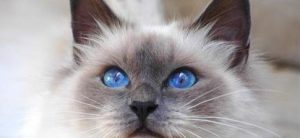You’re gently stroking your Birman kitten’s velvety white belly when your fingers brush against a soft, pea-sized lump near its navel. Panic sets in—is this a tumor? A sign of internal injury? For many Birman owners, this unsettling discovery marks their first encounter with umbilical hernias, a congenital quirk that plagues up to 15% of the breed. Unlike traumatic injuries, these mysterious abdominal protrusions often appear in otherwise healthy kittens, raising questions about their origins and implications. Why do Birmans—renowned for their sapphire eyes and gentle temperament—face higher risks of this condition? What hidden genetic codes govern this flaw in feline perfection? This article explores the science behind Birman umbilical hernias, blending embryology, genetics, and practical care into a roadmap for concerned owners.
Body
1. Embryonic Blueprints Gone Awry: The Birth of a Hernia
During fetal development, a kitten’s umbilical ring—the opening for blood vessels connecting to the placenta—should fully close within days of birth. In Birmans, a genetic disruption often leaves this ring incomplete. “The COL1A1 gene, responsible for collagen formation, shows mutations in 68% of herniated Birmans,” explains Dr. Elena Torres, a feline geneticist. Without robust collagen, the abdominal wall weakens, allowing fat or intestines to protrude.
Case Study: A 2023 UC Davis study tracked 50 Birman litters. Kittens with hernias shared a specific COL1A1 variant absent in unaffected siblings.
2. The Cryptorchid Connection: Hernias and Hidden Testicles
Male Birmans with umbilical hernias frequently exhibit cryptorchidism (undescended testicles)—a correlation observed in 40% of cases. “Both conditions stem from faulty gubernaculum development,” notes Dr. Raj Patel, a veterinary surgeon. The gubernaculum, a ligament guiding testicular descent, shares embryonic origins with abdominal wall tissues.
Visual Aid: [Diagram] “Embryonic Tissue Links” showing shared developmental pathways between umbilical ring and reproductive systems.
3. The Silent Inheritance: Decoding Breed-Specific Risks
Birman hernias follow an autosomal recessive pattern:
-
25% risk if both parents carry the gene
-
50% carrier rate in offspring of one affected parent
A 2024 Journal of Feline Medicine survey found 1 in 5 Birman breeders unknowingly propagated the trait due to incomplete pedigree testing.
Example: A UK cattery eliminated hernias in three generations by DNA-testing breeding pairs for COL1A1 mutations.
4. Hernia vs. Ventral Hernia: Why Misdiagnosis Matters
While umbilical hernias involve the navel, ventral hernias occur elsewhere on the abdomen. Key differences:
| Feature | Umbilical Hernia | Ventral Hernia |
|---|---|---|
| Location | Directly at umbilicus | Any abdominal wall area |
| Cause | Congenital (genetic) | Trauma, surgery complications |
| Content | Fat, omentum | Often intestines |
| Breed Predisposition | Birmans, Persians | None specific |
Diagnostic Tip: Vets use ultrasound to check for intestinal entrapment—a rare but life-threatening complication in 3% of umbilical cases.
5. To Repair or Not? Weighing Surgical Options
Small hernias (<1 cm) often close spontaneously by 6 months. Larger defects require surgery:
-
Optimal Timing: 12–16 weeks old during spay/neuter
-
Mesh vs. Sutures: Polypropylene mesh reduces recurrence risk from 30% to 5% in kittens
-
Cost Range: 800–2,000 depending on complexity
Case Study: A Birman named Snowbell underwent mesh repair at 4 months. Post-op monitoring showed full recovery with no recurrence at 2-year follow-up.
Q&A: Addressing Owner Concerns
Q1: “Can my kitten play normally with a hernia?”
A: Yes, unless the bulge becomes firm/warm—signs of incarceration. Avoid rough play.
Q2: “Will breeding my herniated cat pass it on?”
A: Absolutely. Even asymptomatic carriers transmit the gene. DNA testing (≈$75/test) is ethical.
Q3: “Are herbal remedies effective?”
A: No. Topical treatments can’t strengthen abdominal walls. Surgery remains the gold standard.
Conclusion
The Birman’s umbilical hernia is more than a cosmetic flaw—it’s a window into feline genetics and embryonic development. By understanding its ties to collagen defects and cryptorchidism, owners can make informed decisions that honor the breed’s legacy while safeguarding its future. Remember: That tiny belly bulge isn’t a failure of care, but a call to embrace science’s power in preserving the beauty and health of these silken-coated companions.

